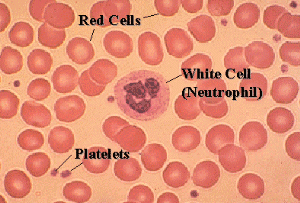
Functions of Blood:
3 - Protection - clotting mechanism protects against blood loss & leucocytes provide immunity against many disease-causing agents
Components of Blood - average adult has about 5 liters (about 5 qts) 
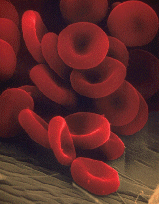
2 - lack a nucleus & cannot reproduce (average lifespan = about 120 days)
3 - transport hemoglobin (each RBC has about 280 million hemoglobin molecules)
4 - Typical concentration is 4-6 million per cubic mm (or hematocrit [packed cell volume] of about 42% for females & 45% for males)
5 - contain carbonic anhydrase (critical for transport of carbon dioxide)
Erythropoiesis
= formation of erythrocytes
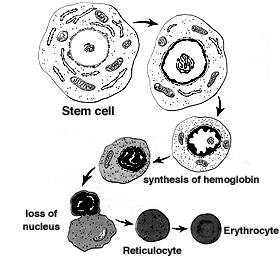
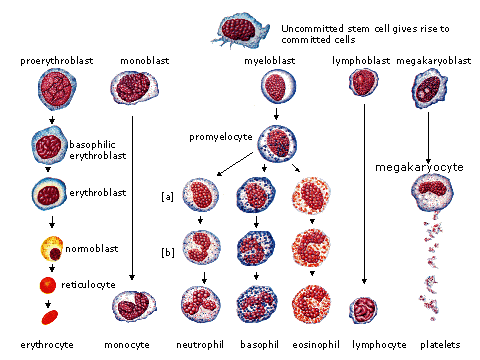
Source: http://greenfield.fortunecity.com/rattler/46/haemopoiesis.htm
Hemoglobin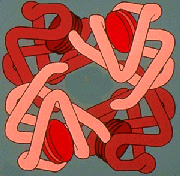
White blood cells (or leucocytes or leukocytes):
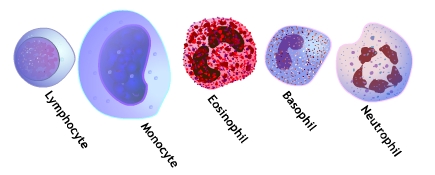
Granular white blood cells contains numerous granules in the cytoplasm, &
their nuclei are lobed. Agranular white blood cells have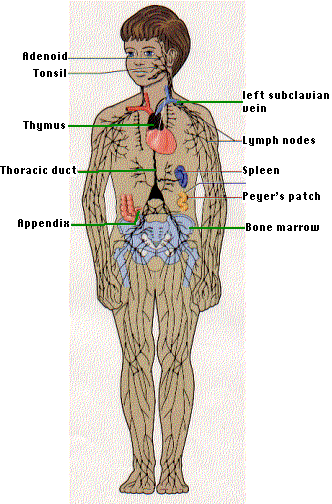 few or no granules in the cytoplasm & have a large spherical nucleus.
Granular white blood cells are produced in the bone marrow, while agranular
white blood cells are produced in lymph
tissue, e.g., Lymph
nodes (specialized dilations of lymphatic tissue which are supported within
by a meshwork of connective tissue called reticulin fibers and are populated by
dense aggregates of lymphocytes and macrophages).
few or no granules in the cytoplasm & have a large spherical nucleus.
Granular white blood cells are produced in the bone marrow, while agranular
white blood cells are produced in lymph
tissue, e.g., Lymph
nodes (specialized dilations of lymphatic tissue which are supported within
by a meshwork of connective tissue called reticulin fibers and are populated by
dense aggregates of lymphocytes and macrophages).
The primary functions of the various white blood cells are:
Some important characteristics of White Blood Cells (particularly neutrophils):
3 - capable of ameboid movement (check out Ameboid Movement - Amoeba)
4 - exhibit chemotaxis (attracted to certain chemicals, such as those released by damaged cells)
Platelets (or thrombocytes)
2 - have no nucleus, but can secrete a variety of substances & can also contract (because they contain actin & myosin)
3 - normal concentration in the blood is about 250,000 per cubic millimeter
4 - remain functional for about 7 - 10 days (after which they are removed from the blood by macrophages in the spleen & liver)
5- play an important role in hemostasis (preventing blood loss)
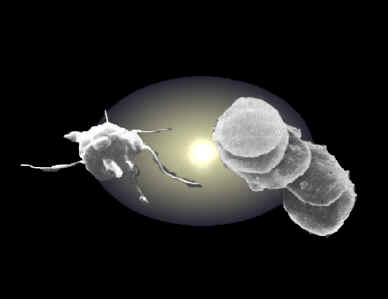
Plasma:
1 - Water - serves as transport medium; carries heat
2 - Proteins
4 - Nutrients - glucose, amino acids, lipids & vitamins
5 - Waste products - e.g., nitrogenous wastes like urea
6 - Dissolved gases - oxygen & carbon dioxide
7 - Hormones
Hemostasis - prevention of blood loss from broken vessel
1 - Vascular spasm - vasoconstriction of injured vessel due to contraction of smooth muscle in the wall of the vessel. This 'spasm' may reduce blood flow & blood loss but will not stop blood loss.
2 - Formation of a platelet plug - platelets aggregate at the point where a vessel ruptures. This occurs because platelets are exposed to collagen (a protein found in the connective tissure located just outside the blood vessel). Upon exposure to collagen, platelets release ADP (adenosine diphosphate) & thromboxane. These substances cause the surfaces of nearby platelets to become sticky and, as 'sticky' platelets accumulate, a 'plug' forms.
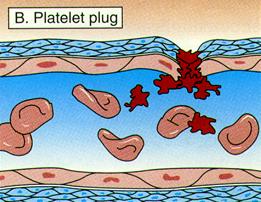
3 - Blood coagulation (clotting):
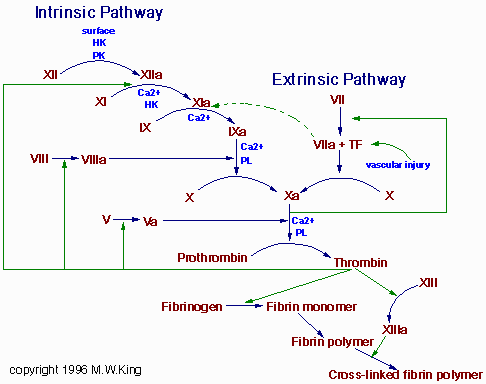
Used with permission of Michael
W. King, Ph.D / IU School of Medicine
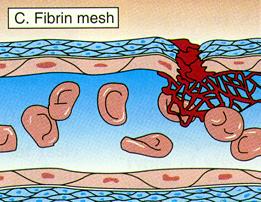
The result of all of this is a clot - formed primarily of fibrin threads (or polymers), but also including blood cells & platelets.

Blood clots in the right places prevent the loss of blood from ruptured
vessels, but in the wrong place can cause problems such as a stroke (see below
under inappropriate clotting).
Clot retraction:
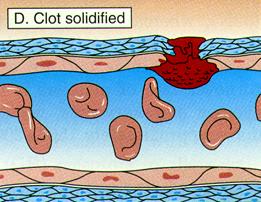
Over time (with the amount of time depending on the amount of damage), the clot is dissolved and replaced with normal tissue.
Fibrinolysis:
Inappropriate clotting:
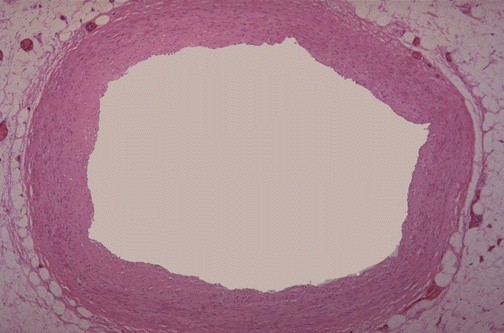

Excessive bleeding: